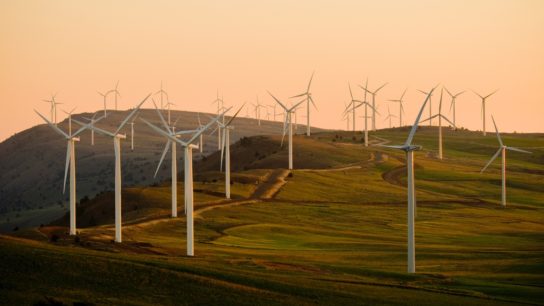Over the last 20 years, negotiations for a “green” goods free trade agreement have taken place on an on-and-off basis without success. Removing the barriers that hamper the free flow of climate-friendly products and services would be a massive step forward in the fight against climate change, as they would make environmental innovation accessible to everyone at lower prices. This endeavour is also critical for achieving the Sustainable Development Goals (SDGs), as Target 9.4 calls for “greater adoption of clean and environmentally sound technologies and industrial processes.”
—
The Trade of Green Goods in Numbers
In 2022, international trade was worth a record US$32 trillion, according to the latest Global Trade Update by the United Nations Conference on Trade and Development (UNCTAD). The report also notes that, despite “decaying economic conditions and increasing uncertainties among global markets that led to negative growth in the last half of the year,” the trade in green goods showed outstanding maturation throughout the year. Commerce in such products grew by 4%, hitting a combined record value of $1.9 trillion and adding more than $100 billion in contrast with 2021.
UNCTAD defines green goods as “environmentally friendly articles designed to use fewer resources or emit less pollution than their traditional counterparts.” Products in this category whose international trade grew the most during 2022 were electric and hybrid cars (+25%), non-plastic packaging (+20%), and wind turbines (+10%).
While some governments already impose relatively low tariffs on different environmental goods, official data compiled by the Organisation for Economic Co-Operation and Development (OECD) shows that others still levy duties as high as 35%. Another problem is that, in many countries, tariffs for non-renewables are considerably lower, removing the competitiveness of green products, especially in developing markets where lower prices attract more demand. Moreover, the liberalisation of trade must not only focus on goods, but also incorporate green services, such as carbon capture, climate monitoring, wastewater treatment, insurance for natural disasters, and others that are critical for environmental conservation.
The Environmental Goods Agreement
The first discussions on liberalising trade in green goods began in 2001 as part of the World Trade Organisation’s (WTO) Doha Round, where member nations agreed that it was imperative to work on “the reduction or, as appropriate, elimination of tariff and non‐tariff barriers to environmental goods and services.”
However, as usual for the multilateral trade system, talks stalled and were put aside for years. It was until January 2014, at the World Economic Forum in Davos, that a group of 18 countries announced their intent to put together a pluri-lateral agreement, hoping to push the matter forward. Those 18 nations – which together represent nearly 90% of global trade in environmental products – were Australia, Canada, China, Costa Rica, the European Free Trade Association (EFTA), the European Union (EU), Hong Kong, Israel, Japan, South Korea, New Zealand, Singapore, Taiwan, Turkey, and the United States (US).
As a result, the Environmental Goods Agreement (EGA) was born in July 2014. It sought to promote commerce in products that “can help achieve environmental and climate protection goals, such as generating clean and renewable energy, improving energy and resource efficiency, controlling air pollution, managing waste, treating wastewater, monitoring the quality of the environment, and combatting noise pollution.”
Despite the effort, negotiations at the WTO tumbled again in 2016 after China and Western countries could not agree on which green goods would be covered by the free trade agreement and subject to tariff exemptions. The opening dialogues were based on an Asia-Pacific Economic Cooperation (APEC) list of 54 environmental goods, while other 300 products were explored throughout the talks.
Last November, the WTO Director-General, Ngozi Okonjo-Iweala, acknowledged during the 27th United Nations Climate Change Conference (COP27) that they “would like to see the revival of an environmental goods and services agreement.” She added that the negotiations should also expand to include environmental services.
A free trade agreement, whether on a regional or multilateral level, is considered critical macroeconomic tools for obtaining preferential admission to foreign markets, promoting economic growth, enhancing efficiency and productivity, fostering innovation, and improving consumer welfare. These benefits also apply to the Environmental Goods Agreement and are spread within three main dimensions: The social, the economic, and the environmental.
On an environmental level, countries participating in the EGA would have extended access to foreign environmental technology that may not be available locally or at affordable prices and may be very needed to combat the effects of climate change. According to the WTO, freeing environmental goods and services from tariffs and non-tariff barriers could reduce carbon emissions by 0.6% as a result of improvements in energy efficiency. Achieving improved environmental performance is in the best interest of national governments because it can increase the flow of foreign direct investment, as businesses perceive less risk from potential extreme weather events.
On a socio-economic level, millions of households worldwide would make considerable gains. According to the International Centre for Trade and Sustainable Development (ICTSD), eliminating tariffs on environmental goods would help American families save $845 million yearly, with lower-income households benefitting the most. Bicycles, LED bulbs, electricity, water, and solar meters are among the products that would contribute the most to the savings. Additionally, the EGA would incentivise the creation of new green industries, jobs, and entrepreneurial opportunities, as well as the transnational movement of skilled professionals in sustainability, which would further contribute to increasing the income of millions of people.
The Environmental Goods Agreement would also benefit the commercial balance sheets of many countries. While there are no official statistics on the size of the environmental industry worldwide, estimates by the WTO calculated it to be $552.1 billion in 2021 and around $690.3 billion by 2026. This expected growth would allow governments to generate more export opportunities for local green goods and services through increased production capacity. The same WTO report calculates that total exports for these products could increase by five and 14% above the baseline.
Despite the visible benefits for a wide variety of stakeholders, experts agree that negotiations for the EGA remain stalled due to three main challenges.
3 Challenges to a Free Trade Agreement on Green Goods
Challenge 1: The Lack of a Definition of Green Goods
The biggest problem during the negotiation process was the lack of a globally accepted definition of “environmental goods”, since many of these products can have a dual use. One example is that, as part of the EGA talks, China proposed that bicycles should be considered environmental goods exempt from tariffs. However, the US and the EU resisted by saying that bicycles are mainly a transportation mode. Part of this challenge is also that, out of the 99 chapters in the Harmonized System nomenclature – the standardised numerical method of classifying traded products that is used by customs authorities worldwide to identify products when assessing duties and tariffs – none refers to the classification of green goods.
Challenge 2: Trade Barriers Remain Present for Green Goods
While the EGA heavily focused on reducing tariffs, non-tariff barriers such as licensing rules, technical standards, and quotas also represent an obstacle to the trade of green goods. These so-called “trade remedies” tend to be deployed by governments under hidden political motivations. Most of the time, instead of balancing international trade, they hinder the production and movement of innovative environmental products that can help many countries in their fight against climate change.
Another concern is the overuse of “retaliatory duties,” defined as taxes that a government charges on imports to punish another country for engaging in unfair trade practices. In a famous 2012 case, the United States concluded that China violated WTO rules by subsidising local manufacturers of solar panels, who also sold them in the American market underneath their production cost, a praxis known as antidumping. In response, the US imposed 30% tariffs on Chinese solar imports. Those sanctions were also applied to Taiwan in 2014 after they found that Chinese firms moved their production to the neighbouring island to dodge the tariff.
China is the largest producer of solar panels in the world, and such retaliatory measures may restrict the adoption of this technology as prices inflate due to the tariff.
Challenge 3: Environmental Innovation Moves Much Faster Than Trade Regulation
Another issue will be managing the speed at which new goods and services are integrated into the duty-free list – if WTO countries ever agree to finish it. In today’s dynamic world, new green technologies emerge and evolve every other day, and it would be unrealistic to expect trade regulations to keep up. WTO members learned this lesson the hard way with the 1996 Information Technology Agreement, which aimed to eliminate tariffs on hundreds of information technology goods. The list of that treaty remained unchanged for nearly 20 years until exhaustive negotiations led to the addition of new products, such as tablets and smartphones.
Conclusion
Making negotiators return to the table to revive the Environmental Goods Agreement will increase access to foreign environmental goods and services that many countries need to fight climate change and achieve their Sustainable Development Goals. For this matter, world leaders should realise that not a single nation has the resources and capacity to rely exclusively on its own production of green technology, reason for which a free trade agreement on green goods is urgently needed.
Governments cannot overlook international cooperation when dealing with environmental matters, just like they should not try to tackle economic and environmental issues separately in a globalised world. As recognised by UNCTAD, “the patterns of international trade are anticipated to become more closely tied to the transition towards a greener global economy.”
You might also like: Renewables Will Dominate World’s Electricity Demand Through 2025, IEA Report Says














